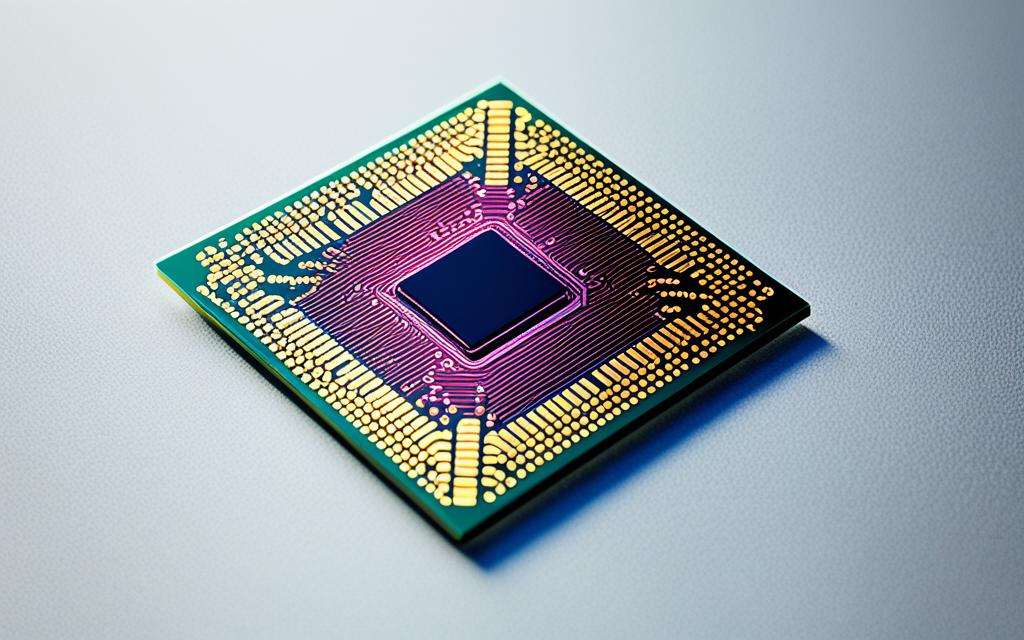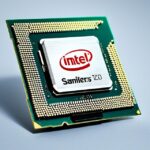Table of Contents
RISC (Reduced Instruction Set Computer) CPU architecture aims to make computing more efficient by simplifying instruction sets. This makes RISC CPUs very fast, allowing them to handle millions of instructions per second1. RISC architectures, like ARM and MIPS, are widely used in various devices. They can execute instructions quickly, often in just one clock cycle1. RISC also enables pipelining, which speeds up instruction processing and boosts performance1.
RISC systems are simpler and cheaper to design than CISC systems2. As technology advances, knowing about RISC CPU hardware is crucial. It helps in tapping into its full potential in many areas.
Key Takeaways
- RISC CPU hardware focuses on a simplified instruction set for enhanced performance.
- It aims for high-speed processing with fewer cycles per instruction.
- RISC architectures are commonly found in devices that require efficient computing.
- They offer cost-effectiveness by utilising fewer transistors than CISC processors.
- Pipelining is a key feature that improves overall CPU efficiency.
- RISC technology is increasingly dominant in current microchip designs, particularly RISC-V.
Understanding RISC Architecture
The RISC architecture marks a big leap in how computers work, aiming for speed and simplicity. By focusing on easy-to-manage steps for operations, it achieves quicker outcomes. At its core, RISC is about doing things fast and with minimal steps, featuring single-clock cycle execution, lots of general-purpose registers, and simple ways to handle data3.
Definition and Key Principles
RISC’s goal is to make computer instructions straightforward yet powerful. It shines in doing tasks quickly, thanks to its one-cycle execution approach. Since the IBM 801 project in the 1980s, RISC has aimed for high performance, capable of managing millions of instructions per second. Plus, it’s crafted to use energy efficiently, perfect for portable gadgets4.
Comparison with CISC
In comparing RISC with CISC, clear distinctions stand out. CISC has bulkier instructions that slow it down since they take several cycles to complete. On the flip side, RISC opts for a leaner instruction set for speedier processing. It also has more registers for operations, opposite to CISC’s comparably limited number3. RISC excels in breaking complex tasks into easier bits, boosting its efficiency and performance.
Advantages of RISC CPU Hardware
RISC CPU hardware benefits are clear in our speedy tech world today. It focuses on top performance and saving energy. This makes it top-notch for tasks that need strong processing.
High Performance per Watt
RISC CPUs stand out by giving lots of power with little energy use. This is key for devices that must save battery. They use a technique called pipelining, letting them do many instructions at once. This can speed things up and use less energy5. RISC CPUs also have higher clock speeds. They can be up to 40% faster at some jobs than more complex CPUs, showing they can easily handle tough computational tasks5.
Faster Execution Speed
RISC processors are fast because they finish an instruction each clock cycle6. This method is more direct compared to CISC, which might need several cycles for one job due to complexity6. Having fewer instructions means less hardware space is needed. And with lots of general-purpose registers, data is reached quicker5. This blend of speed and low energy use means RISC is still a strong choice for both developers and producers.
| Attribute | RISC | CISC |
|---|---|---|
| Clock Speed | Higher clock rates yield faster execution | Lower clock rates |
| Instruction Set | Smaller, simpler set | Complex with more instructions |
| Execution Cycle | Executes one instruction per cycle | Takes multiple cycles per instruction |
| Energy Efficiency | Higher efficiency and lower power consumption | Less efficient |
| Hardware Cost | Less expensive to develop due to fewer transistors | More expensive with complex circuitry |
RISC processors bring together efficiency, simplicity, and strong performance. They mark a big plus in today’s computing world7. With technology moving forward, their ability to fuel specific applications hints at thrilling future developments in computing.
Key Characteristics of RISC CPUs
The key characteristics of RISC CPUs significantly boost their performance in today’s computers. Their design focuses on efficiency. This is key to achieving fast and reliable processing in devices.
Simplified Instructions
RISC architecture makes instructions simple, allowing them to execute quickly. This means it can perform many tasks in a short time. The simplicity of these instructions speeds up processing.
Load-Store Architecture
RISC CPUs use a load-store architecture that keeps memory access and data processing separate. This setup lets information stay in registers for direct operations. Thus, it avoids unnecessary memory use and speeds up complex tasks.
Pipelining Advantages
The ability to use pipelining is a standout feature of RISC. It lets the CPU work on several instructions at once, increasing speed. This, along with simplified instructions and load-store architecture, boosts efficiency. The massive shipment of over 10 billion RISC-V cores worldwide shows the high demand for this technology8.
RISC, especially RISC-V, offers flexible and cost-effective solutions. It shines in applications from home computing to gaming systems tailored to specific needs9. With the rising need for energy-efficient processors, RISC is set to influence future tech developments10.
Which of the following is true about RISC CPU hardware?
Learning about RISC CPU hardware uncovers interesting facts about RISC CPU hardware. These speak to its high performance. By simplifying instruction sets, RISC enables quicker execution of operations. This approach boosts efficiency too. For example, in some tasks, RISC CPUs are 40% faster than complex ones5.
They accomplish tasks rapidly, often in one clock cycle. This quick action outpaces CISC models significantly5.
The core feature of RISC is its load-store architecture. It often includes 16 to 32 fast, multi-use registers4. These registers help quicken memory access, boosting speed5. RISC also benefits from smart pipelining. This lets it process several instructions at once, enhancing clock rates5.
Examples like Sun Microsystems UltraSPARC and ARM show how well RISC works, especially in embedded systems4. RISC is great for multitasking requiring high efficiency5. Knowing this helps us value RISC’s role in contemporary computing.
Conclusion
RISC CPU hardware has changed the way we think about computer architecture. Its focus on high speed and energy saving shows that simplicity can bring benefits. This approach allows for quick command execution, boosting processor performance and speed. Also, by using fewer memory accesses, RISC increases work efficiency11.
Looking ahead, the future of RISC is bright, thanks to advances like SiFive’s U8-Series CPUs. These new models are up to five times faster than earlier ones. Such progress not only keeps RISC relevant but also proves it’s suitable for many computing needs, including advanced operating systems12.
The enthusiasm for RISC CPU hardware points to a bright future for efficient computing. Engineers using RISC can meet today’s tech challenges head-on. They’re gearing up for a world that demands more speed and power efficiency, making RISC a key player in modern computer design13.
FAQ
What is RISC architecture?
RISC stands for Reduced Instruction Set Computer. It is a type of CPU design that aims to speed up processing by simplifying the set of instructions. This design uses a load-store model where it keeps memory access and arithmetic tasks separate.
How does RISC differ from CISC?
RISC, or Reduced Instruction Set Computer, differs from CISC, Complex Instruction Set Computer, by using a simpler set of operations that can be executed quickly. Unlike CISC, RISC doesn’t do many tasks per instruction, leading to better speed because its instructions are less complex.
What are the main advantages of RISC CPUs?
RISC CPUs offer several benefits. They provide high performance for each unit of power consumed and can execute tasks swiftly. Their streamline architecture leads to greater efficiency, making them perfect for gadgets that need to save on power.
What is meant by load-store architecture in RISC?
The load-store model in RISC means it does data handling and computing tasks separately. It processes arithmetic tasks between registers directly. This approach helps in making the most of high-speed registers and boosts performance.
How does pipelining enhance RISC CPU performance?
Pipelining lets RISC CPUs deal with several instructions at once. This increases how much the CPU can do without a pause and makes better use of its resources. It’s great for handling lots of tasks smoothly and with good speed.
Is RISC suitable for both mobile and desktop computing?
Yes, RISC works great across various tech environments. Its efficiency and speed make it an excellent choice for mobile gadgets. At the same time, it’s powerful enough for demanding computing tasks, like those on supercomputers.
What challenges does RISC architecture face?
RISC’s simplified approach means it often needs more steps to finish complex tasks, compared to CISC. This can make the code bigger and sometimes less efficient in some scenarios.
Can RISC processors be used in supercomputers?
Indeed. RISC processors, including popular ones like ARM and SPARC, have pushed supercomputing forward. They excel at doing simple tasks very efficiently, which makes them adaptable to different types of computing needs, including supercomputers.
Source Links
- https://www.techtarget.com/whatis/definition/RISC-reduced-instruction-set-computer – What Is RISC (Reduced Instruction Set Computer)? | Definition from TechTarget
- https://teachcomputerscience.com/risc-and-cisc-processors/ – RISC and CISC Processors | What, Characteristics & Advantages
- https://www.geeksforgeeks.org/computer-organization-risc-and-cisc/ – RISC and CISC in Computer Organization – GeeksforGeeks
- https://en.wikipedia.org/wiki/Reduced_instruction_set_computer – Reduced instruction set computer
- https://ms.codes/en-gb/blogs/computer-hardware/which-of-the-following-is-true-about-risc-cpu-hardware – Which Of The Following Is True About Risc CPU Hardware
- https://chipedge.com/risc-vs-cisc-which-is-better/ – RISC Vs CISC: Which is Better?
- https://cs.stanford.edu/people/eroberts/courses/soco/projects/risc/risccisc/ – RISC vs. CISC
- https://www.esper.io/blog/what-is-risc-v – What is RISC-V?
- https://per-international.com/news-and-insights/risc-vs-cisc-architecture-which-is-better – Electronics & Semiconductor Recruitment Consultancy | PER-International
- https://siliconsemiconductor.net/article/118597/Microprocessor_architecture_choice_in_the_age_of_AI_exploring_ARM_and_RISC-V – Microprocessor architecture choice in the age of AI: exploring ARM and RISC-V – News
- https://www.educative.io/answers/what-is-risc-architecture – What is RISC architecture?
- https://www.anandtech.com/Show/Index/15036?cPage=4&all=False&sort=0&page=3&slug=sifive-announces-first-riscv-ooo-cpu-core-the-u8series-processor-ip – SiFive Announces First RISC-V OoO CPU Core: The U8-Series Processor IP
- https://www.geeksforgeeks.org/very-long-instruction-word-vliw-architecture/ – Very Long Instruction Word (VLIW) Architecture – GeeksforGeeks








